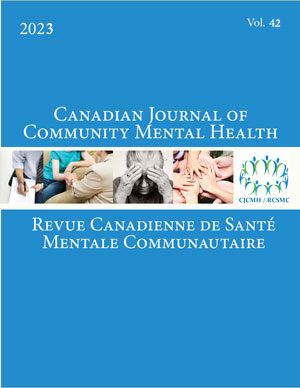Volume 42 • Number 4 • December 2023
Articles
Rural regions across North America continue to suffer from a lack of community-level mental health supports. This exploratory study explores whether Men’s Sheds, bottom-up, community-driven groups designed to support retired and older men’s mental health by mimicking the social and collaborative aspects of “work-life” by creating opportunities to engage in project-based woodworking, metalworking or mechanics, are generating positive mental health outcomes for their members in rural communities in Alberta, Canada. Relying on a set of semi-structured interviews with participants across two rural Alberta Men’s Sheds, in addition to a sociodemographic and self-rating questionnaire, we demonstrate that the participants in these Sheds enjoy clear and significant mental health benefits by generating opportunities for camaraderie, a sense of purpose and a sense of inclusion. Although not an appropriate substitute for more formal mental health supports in certain situations, we conclude that supporting the formation of new Men’s Sheds throughout rural areas represents a worthwhile investment in the mental health of a group of vulnerable citizens.
Findings from a novel Primary Care (PC) Mental Health (MH) pathway for children and young people in Northern Ontario, Canada are presented. Overall, 166 MH referrals from PC to a community-based child and youth MH and addictions agency (CB-CYMHA) occurred, with outstanding PC uptake (100%) and faxing referral outcomes (99%) from the CB-CYMHA to the PC provider. Half of referral outcomes (50%) were returned within 2 weeks and 83% of contacted clients reported satisfaction with services received. This successful pilot serves as an example for care pathway improvements and mobilizes knowledge for other pathway sites across Ontario.
This study explored factors impacting caregiver burden (CB) in families of youth with mental health and/or addiction (MHA) issues through a cross-sectional survey of Ontario caregivers (n = 259). Zero-order correlations explored caregiver, youth, and service factors and CB. Regressions explored contributions of significant factors to the variance in CB. Barriers to services, number of youth symptoms, and waitlist status significantly predicted CB. The specific barriers that were significantly associated with CB were service costs, service availability, and youth motivation to participate in services. Tailoring interventions and policies to reduce service waitlists and barriers may alleviate CB and improve youth and family outcomes.
Using a series of nationally representative cross-sectional surveys, this study shows that younger Canadian adults (aged 18–34) rated their own mental health positively (as “very good” or “excellent”) less often than older adults (i.e., 35+), both before and during the pandemic. Also, younger adults’ positive mental health ratings declined particularly sharply following the onset of the pandemic, with declines of more than 25 percent between the pre-pandemic (60.9% [95% CI 59.3-62.4]), and the pandemic (e.g., 43.8% [95% CI 38.7-49.0]) periods. Young adult women appeared particularly vulnerable, but immigrant youth showed signs of resilience.
In this qualitative study, researchers interviewed 10 participants (five mentees and five mentors) of the 2020–2021 Artemo Black Youth Mentorship program session. The Artemo program takes place with Black youth across Alberta, with a focus in Edmonton, Calgary, and Fort McMurray. The program focuses on providing supports for a mental health preventative approach, employment/educational supports, and a gender intersectionality focus throughout Alberta. To assess the program, organizers hired an independent researcher to maintain anonymity. Findings from the interviews spoke to larger themes related to Black youth mental health and well-being, as well as community-based approaches to supporting them. Our findings offer three key themes. First, youth offered their own perceptions of mental wellness. Second, they explained stigma, a lack of cultural competency and representation among service providers, and financial costs, as significant barriers to mental health and wellness. Third they discussed opportunities for youth mentorship to fill service gaps and act as a form of resistance. Opportunities include strategies to navigate mental health stigma, opportunities to build trust, benefits of centralizing experiences of race and culture, and benefits of non-medicalized mental wellness support.
Post pandemic increases in mental illness and waitlists for mental health services highlight the urgent need to prevent and mitigate mental health problems in children and youth living in Canada. We describe current dissemination and implementation strategies of evidence-based preventive interventions (EBPIs) for children and youth in Canada that are designed to improve health and well-being. Based on written case studies from 18 Canadian researchers and stakeholders, we examined their approaches to development, dissemination, and implementation of EBPIs. We also summarized the opportunities and challenges faced by these researchers, particularly in sustaining the dissemination and implementing of their evidence-based programs over time. Typically, researchers take responsibility for program dissemination, and they have created a variety of approaches to overcoming costs and challenges. However, despite the availability of many strong, developmentally appropriate EBPIs to support child and youth mental health and well-being, systemic gaps between their development and implementation impede equitable access to and sustainability of these resources.
Practice Innovations
This article explores the integration of cultural continuity in health programs for Indigenous youth, leveraging insights from Indigenous Youth Wellness Facilitators, in the Culture Is Healing program. It identifies four practices and their impacts, strengthening community and identity among Indigenous youth. The findings provide valuable recommendations for practitioners and policymakers.









